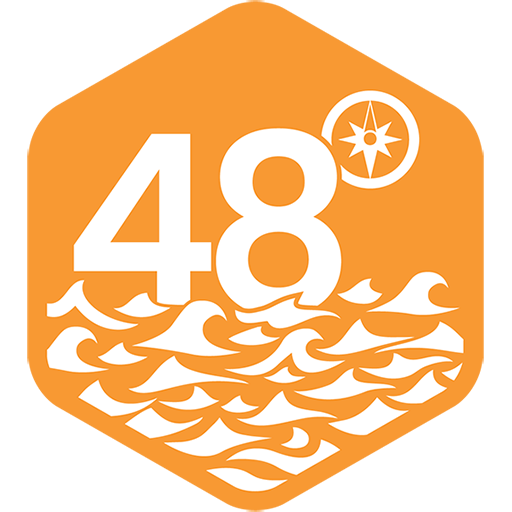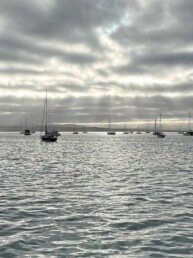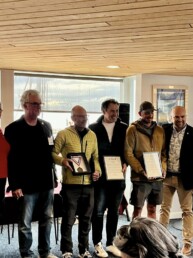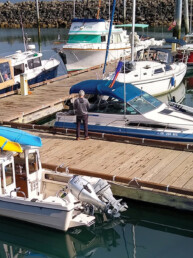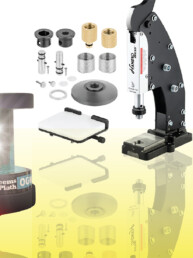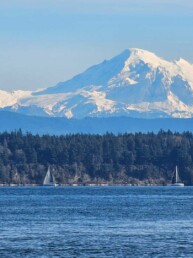Stories from the four awesome women sailing and pedaling their well-traveled Santa Cruz 27, and details from their fellow Bellingham-area teams on the epic WA360 adventure race.
WA360 is the brilliant brainchild of the same people at Port Townsend’s Northwest Maritime that brought you the famous Race to Alaska (R2AK). The race course is approximately 360 miles, but you certainly sail more than 360 miles, and I’m sure it feels like 3600 if you’re doing it under human power alone. I was sailing as part of Team Salish Seasters, homeported in Bellingham—a sailing community that sent six teams to WA360, several of whom we interacted with quite a lot during our race.
The race starts in Port Townsend, and first heads 77 miles south to Olympia. Right off the bat, you have to decide if you’re going inside or outside Marrowstone Island, and among the many obstacles and decisions on the first leg is the Tacoma Narrows. After rounding Olympia Shoal, the next leg is 91 miles back up to Goat Island on the south end of the Swinomish Channel, passing back through the Narrows and the full length of Puget Sound. You can take Swinomish Channel or you can cut through Deception Pass on your way north, both equally nail-biting because of strong currents and narrow passages. The channel is much longer and has a lot more boats and obstacles, but it has softer edges and no scary whirlpools. From the end of the Swinomish Channel, it’s mostly open water for the remainder of the race. There’s 25 miles to Bellingham Bay, and then about 25 more miles to Point Roberts. The final leg back to Port Townsend is 50 more miles, with lots of navigational options through or around the San Juan Islands.
Besides the course, the biggest thing about the race is the people who do it and the boats that they choose. All shapes and sizes of boats, racers of all ages, from 8 to well… surely older than me. At the starting line, 83 teams took to the water. There are two main divisions, human power (Muscles) and boats with sails (Wind). Most of the human powered boats are very small, many singlehanded. There were paddleboards and kayaks, rowboats and ocean rowboats. The Boogie Barge is a breathtakingly creative home-built catamaran with bicycles and oars, and they led the way in human power, even after taking two days off mid race to attend to shoreside responsibilities. In the wind power category, almost every boat also had some form of human power as well. Most boats had some sort of pedal drive, at least when they started the race! A couple boats relied on carrying a dinghy to launch and tow them along through the slow sections, notably Bill and Darlene Stange’s Westsail 32 Hula. It would be hard enough to pull that off by anyone at any time, but imagine doing it in that boat, married to the person in the dinghy.
With good breeze for the majority of the race, the multihull sailboats definitely had a speed advantage over the rest of the fleet. Wind power boats ranged from 30-ish foot race boats to tiny row boats with tiny gaff rig sails, to little trimaran sailing dinghies. Some fully crewed boats raced day and night, eyeing a finish in just a few days, where the littlest human and wind power racers planned to camp each night along the way and take the entire two weeks to complete the journey. There is definitely more than one way to experience the event—all with a potential for fabulous or painful in their own way.
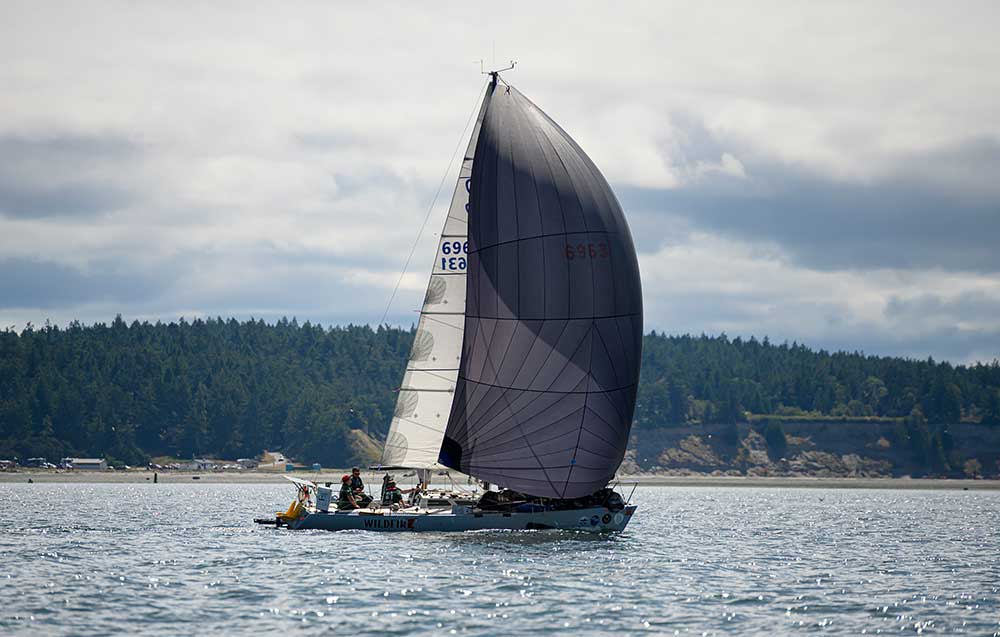
Aboard Team Salish Seasters, each of us has a sailboat of our own. Our trusty ride for the WA360 was the Santa Cruz 27 Wild Card, which had completed the Race to Alaska twice and attempted the inaugural WA360 in 2021, and is a great platform for both. One of us Salish Seaters, Katie Gaut, raced Wild Card in the 2024 R2AK with team Sail Like a Mother and has a lot of sailing miles under her keel. Melanie Conner Lyons is the new owner of the boat, and is a seasoned river rafter, kayaker, and adventurer. Karen Gunn is an experienced river rafter and sea kayaker. I was the only sailboat “racer” on board, per se, and my racing terms for everything kept everyone entertained. WA360 isn’t a traditional sailboat race by any stretch, and everyone contributed in their own way.
There were a lot of boat projects, and just a couple practice sails before we took on the challenge together. There were many considerations! Which sails to bring? What about the bow pole and oversized kite? The G0? A storm sail? Tighten up the rig and the backstay! Will the pedal drive be okay? Paddles? How much water? How much beer? What will we do about using the head? We ended up bringing at least twice as many provisions as necessary, and far too many chips to go with the yummy freeze dried salsa.
Some teams were far more prepared than others, and we were probably “well enough” prepared—somewhere between the well oiled machines in the front and our buddies on Team Wild Unos on a Wilderness 30 who survived on Wheat Thins while using three sails purchased for $300 on Craigslist right before the race (one they nicknamed Scrotum because of its shape’s striking resemblance). Spoiler alert, they beat us to the finish in the race.
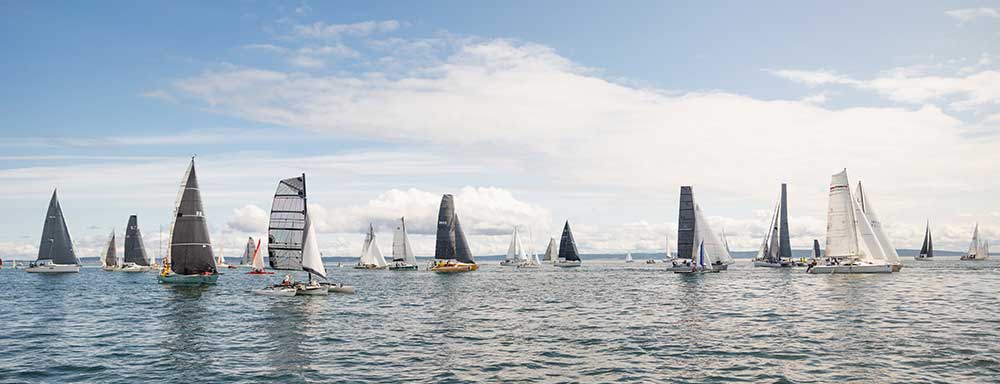
After a community breakfast at Northwest Maritime, we set out for the starting line on a late June Saturday. All 83 boats started together, going south across the line after the ferry cleared the area. Port Townsend bay was very busy with race boats and spectators circling in a slight, but sailable breeze. On Wild Card we were about two minutes away from the middle of the line with about a minute to go when I remembered that we could pedal. With an extra knot of speed we were just about on time in the middle of the line.
With a northerly breeze, boats who wanted to take the outside of Marrowstone owned the boat end of the line and turned upwind. We had made a solid plan to take the inside, and stuck with it even after seeing some friends head the other way. Southbound boats hoisted kites and there was a bit of pedaling here and there in the lulls, but it was an easy passage under the bridge and out to Puget Sound despite some unwanted fiddling around with the kite sock on our part. That darn thing!
For quite a while the conditions and shorter distance favored the inside boats, but eventually it filled in stronger on the outside and it all evened out. It was a great kite run down the Sound and the only big decision was inside or outside Vashon. It appeared that there might be more breeze outside but ultimately it was just a greater distance and it didn’t pan out.
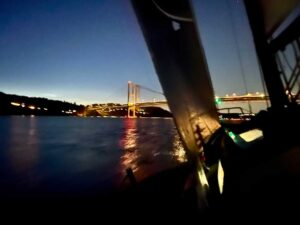 We arrived at Tacoma Narrows as it was getting dark. It was a bit intimidating to pass through at night in a decent breeze with the kite up and in close quarters with Team Wild Unos (you’d be surprised how we were right with them, maybe Wild boats are magnetically drawn to each other). After wrangling the kite to the deck we heard a power boat approach in the dark calling out “Wooohoo Salish Seasters!” We thought that the media boat might want to discuss our sail handling skills, but instead a friend had been following us on the tracker and found us out in the dark just to cheer us on!
We arrived at Tacoma Narrows as it was getting dark. It was a bit intimidating to pass through at night in a decent breeze with the kite up and in close quarters with Team Wild Unos (you’d be surprised how we were right with them, maybe Wild boats are magnetically drawn to each other). After wrangling the kite to the deck we heard a power boat approach in the dark calling out “Wooohoo Salish Seasters!” We thought that the media boat might want to discuss our sail handling skills, but instead a friend had been following us on the tracker and found us out in the dark just to cheer us on!
The first night continued on with a bit of anchoring and a bit of pedaling, along with some sailing any time we could; and not a lot of sleeping for anyone on board.
By the time the sun rose in the morning, we were nearing the end of Anderson Island pedaling along enjoying coffee with a beautiful view of Mount Rainier. The lead boats were already on their way back—dang! The South Sound is beautiful, with lots of bays and shoals and inlets and opportunities for some boats to just set the anchor and go swimming, especially when there was too much current to make forward progress. Team Moore On even pulled out some pool toys for a break along the beach.
At some point we had renamed all of the boats around us, and everyone had a new name that included Sisters. One of our favorite boats in the race was the Bellingham based father-daughter duo on Team Cinderella Story. Karen was on the pedal drive with her Crocs that morning when one of them flipped off, which was eventually returned by a friendly couple in a runabout—so we were also team Cinderella, as the Croc was reunited with its princess. That evening we celebrated finally passing one of our local teams, Spare Parts also from Bellingham, with some reconstituted lasagna and Kirkland wine during the sunset. We also made it back through the Narrows before dark, spending the second night in Colvos Passage. The skies turned a beautiful pinkish orange at around 4 a.m., and we enjoyed the sunrise from Blake Island to Shilshole. It was a beautiful northerly, until it wasn’t. Before long, we were all good and tired of looking at South Whidbey Island, spending a few hours just getting one mile forward so that we could set our anchor. After some bad ideas (like going outside Whidbey) and a good team meeting, the breeze filled in… to the tune of 25 knots.
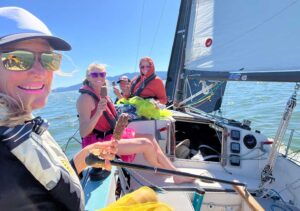 Just when we were talking about putting in a reef near Langley, along came a little runabout, full speed in our direction. We were starting to wonder what the heck was going on when Karen said “hey, that’s my family!” We received pizza wrapped with inspirational messages and popsicles for dinner that night. The bounty was also shared with eight other race boats along the path from their cabin on the island.
Just when we were talking about putting in a reef near Langley, along came a little runabout, full speed in our direction. We were starting to wonder what the heck was going on when Karen said “hey, that’s my family!” We received pizza wrapped with inspirational messages and popsicles for dinner that night. The bounty was also shared with eight other race boats along the path from their cabin on the island.
It was an easy upwind sail that night, hugging the Camano Island shore. We hoisted the kite as the sun rose in the morning at the top of the island. Up ahead, some boats had anchored for the evening and were just waking up for the day. Next up, Goat Island!
On Team Salish Seasters, the big decisions were made democratically. While our timing might be okay for Deception Pass, the Swinomish seemed like the safer bet and we had several boats around us who all went that way. So, off we went! At first we had the wind and current with us—an easy ride up to the town of LaConner. After that, we probably put in 100 tacks in a narrow channel while dodging powerboats going full tilt. In one of the 12 lead changes between our teams, the Wild Unos stuck it hard in the mud on the north side of the channel. Evidently they were receiving coffee from the kind souls on Team Unicorns with Pretty Horns and took it just a bit too far. Swimming with an anchor out into the channel and kedging themselves free, they eventually shook loose and got us back for the last time in Bellingham Bay. On board Wild Card, we enjoyed a fun entourage of encouragers at the Bellingham mark with kayaks and a skiff and a sailboat with bags of treats that included ice cream and girl scout cookies. It’s good to be loved in your home town.
After a breezy slog upwind with small sails in Bellingham Bay, the wind shut off completely in Hales Pass between Lummi Island and the mainland, or as Mark Bunker on Team Never Get Off the Boat called it, “Hells Passage.” We were reunited with boats that we hadn’t seen in a day or so. Shifting gears and connecting the dots, we all made it through and I think everyone in our vicinity had a lovely sail to Point Roberts that evening.
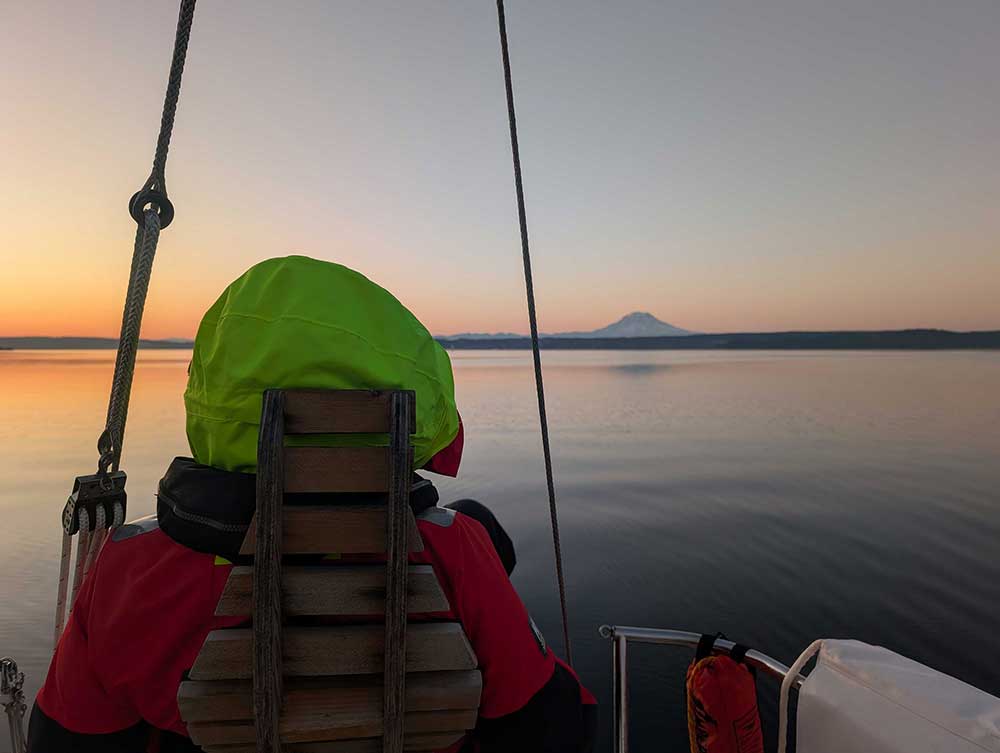
Our night watch, on the other hand, was less pleasant. Most boats took the route past Orcas Island down Rosario Strait that night, but some took a more northern route past Sucia and Waldron down Cattle Pass. Rosario seemed like the safe choice with more open water in the big wind that night, and that’s the route we chose. Of the two boats that went north, one made out like bandits and one sadly hit a rock. It was a calculated risk for sure, with potential for big gains. We Salish Seasters tucked into the north end of Lummi Island to reduce sails and at 2 a.m. we got a call from the former owner making sure we were okay. It’s great to know that people are looking out for you.
The Bellingham teams kept in close communication throughout the event, and our friends on Team Yes! (the Si!-sters) kept ducking for cover until they were eventually all the way back to Fairhaven for the night, but got up the next morning and got right back after it. Hazel and dad Craig stopped each night on Team Cinderella Story and got right back on course first thing each morning. It was really something to realize how close they remained to us throughout the race.
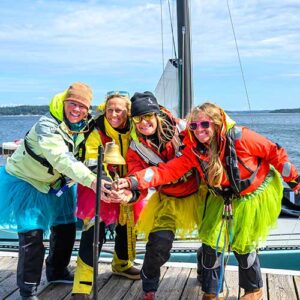
After spending some time under mainsail only that night, the wind took a break for our dawn patrol shift and we were drinking coffee with all the sails back up in the tide rip at the Peapod Rocks on our final day. We kept dancing with the thresholds for putting sails up and taking them down, and we always allowed the wind 5 minutes to decide if it’s really serious. There were a few sail changes before we really settled in on the final push across the Strait to Port Townsend.
We were flying along under the #3 with one reef, and we had Team Monkey Fist’s Olson 30 in our sights. We tried to catch them to no avail, but it was a fabulous day to surf down waves in the sun and we arrived in time to clean up the mess we made down below and still get to Sirens in time for happy hour.
Would I do the race again? Definitely. Would I get right back out there today? Probably! As I write this, I’ve been ashore for several days and some teams are still out there sailing and paddling their hearts out. Whether or not you have Race to Alaska ambitions, this race is just cool.
Congratulations to Team Puget Sound Navigation Company, sailing a flawless race and finishing in 2 days 18 hours and 24 minutes, crushing the previous course record on their Gougeon 32 catamaran Incognito. Shortly behind them were Team Narrows Minded, JED Racing, Ruf Duck, and there are really too many team stories to tell here—all inspiring. Start now with your pedal drives and give it a go. WA360 will now be on the odd years, with the Race to Alaska on even years. Choose your adventure!
Title background image by Taylor Amble.
Stephanie Campbell
School teacher by day, rad racer by night and weekend, and 48° North's lead racing reporter in between—Stephanie Campbell of Anacortes, WA, is one of the Salish Sea's most respected sailors. Her trophy wall is jam-packed and includes a Santa Cruz 27 National Championship. She's the proud owner of SC27, Wild Rumpus, and Martin 24, Area 51.
